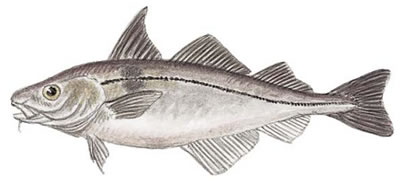Closely related to the genus Gadus, the haddock is often considered a member of the Gadidae, or codfish, family. Haddock have long been important commercially and are an even more highly valued food fish than Atlantic cod, although stocks of haddock have declined rapidly since the 1960s due to overfishing.
Identification
The haddock has three dorsal fins and two anal fins; the first dorsal fin is high and pointed. The small chin barbel is sometimes hidden. Its coloring is purplish gray on the back and sides, fading to pinkish reflections and a white belly. There is a black lateral line along the side and a black shoulder blotch. The dark lateral line and the shoulder blotch can distinguish it from its close relatives in the cod family. Three dorsal fins distinguish the haddock from its relative the silver hake (see: Hake, Silver).
Size/Age
The average haddock is 1 to 2 feet long and weighs 1 to 5 pounds. The all-tackle record is 11 pounds, 3 ounces, but they have been reported to attain 161⁄2 pounds. Haddock can live for 14 years.
Life history/Behavior
The spawning season is between January and June, and activity peaks during late March and early April, when large congregations form in depths of 20 to 100 fathoms. Major spawning concentrations occur on eastern Georges Bank, although some spawning also occurs to the east of Nantucket Shoals and along the Maine coast. Haddock swim in large schools, and there is some seasonal migration to the north in the spring and south again in the fall. Adult haddock on Georges Bank appear to be relatively sedentary, but seasonal coastal movements occur in the western Gulf of Maine. There are extensive migrations in the Barents Sea and off Iceland.
Food and feeding habits
Primarily consuming crabs, snails, worms, clams, and sea urchins, the haddock seldom feeds actively on fish.
Other Names
haddie, scrod; French: eglefin; Italian: asinello; Norwegian: kolje; Portuguese: arinca, bacalhau; Spanish: eglefino.
Distribution
In North America the haddock is found from Newfoundland and Nova Scotia southward to southern New Jersey. It occasionally inhabits the deep water to Cape Hatteras. The highest concentrations off the U.S. coast occur on the northern and the eastern sections of Georges Bank and in the southwestern Gulf of Maine. Two stocks occur in U.S. waters: the Gulf of Maine stock and the Georges Bank stock.
Habitat
Preferring deeper water than do cod, haddock inhabit depths of 25 to 75 fathoms. Although generally a coldwater species, preferring temperatures of 36° to 50° F, they are commonly found in warm water over bottoms of sand, pebbles, or broken shells.


